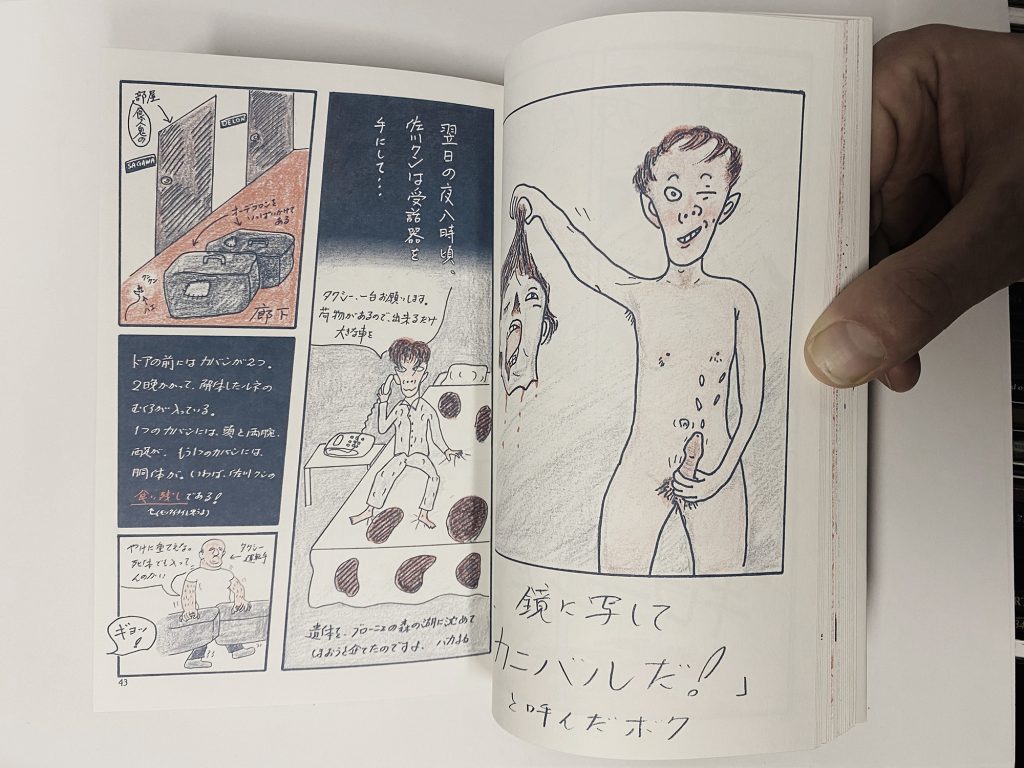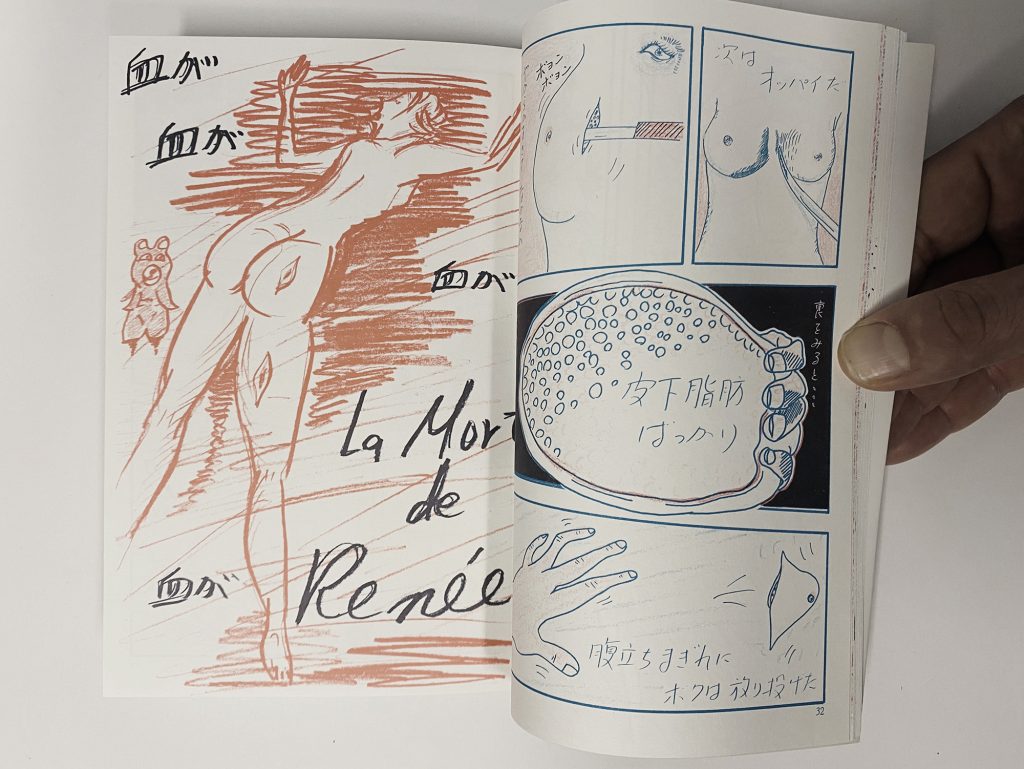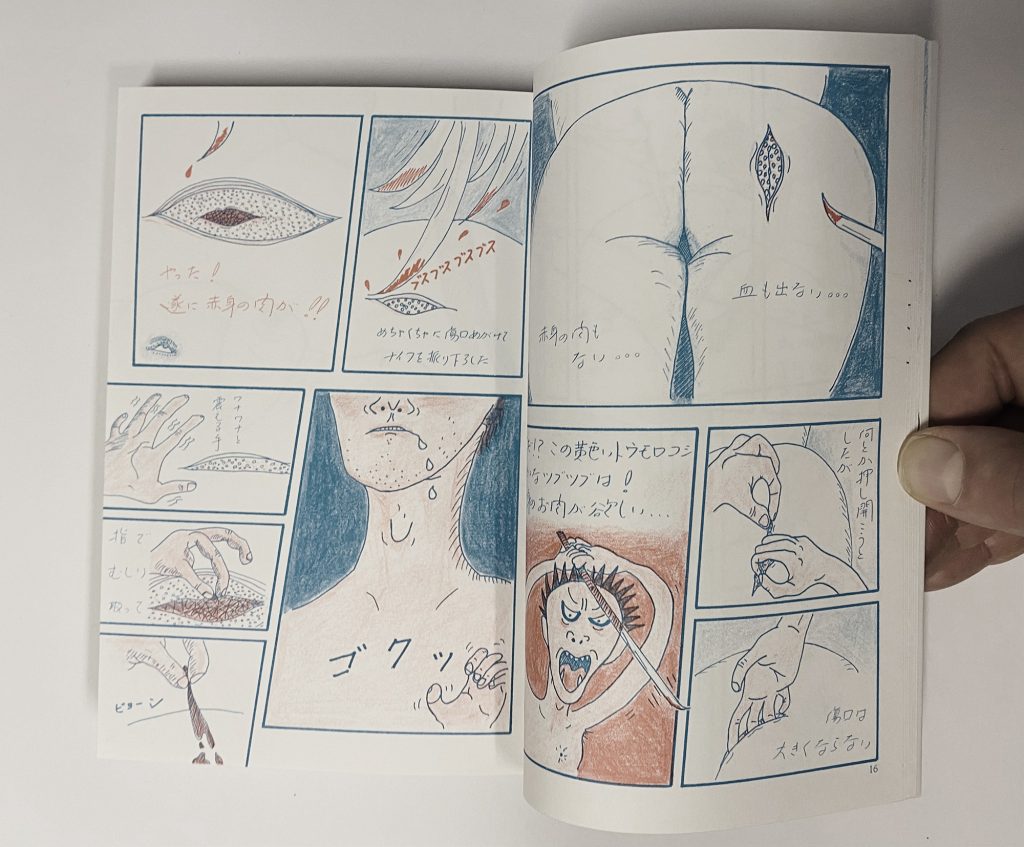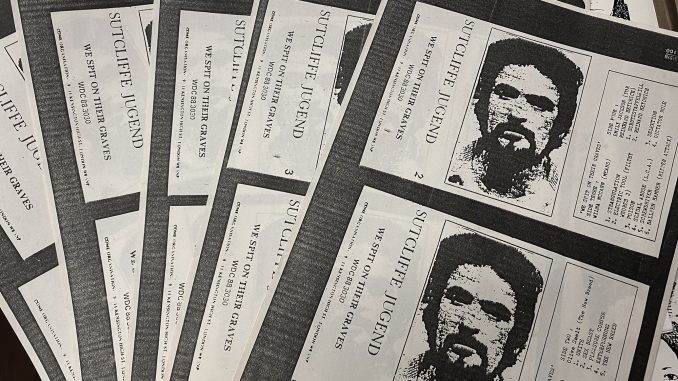
By: Mikko A.
During 2021 there was turbulence in Finnish cultural field. Campaign under tag punkstoo was launched with intent to reveal hidden side of that particular music culture. Abuse and misogyny within Finnish punk and hardcore circles had been occasionally brought up over the years, but had remained hidden from wider public. Soon followed metaltoo and other very similar projects. All these were social media accounts focusing on specific area of culture. None of them caught the momentum like short lived punkstoo that started it. It is possible that some of them were not as successful, simply due being less about rape and violence or other illegal acts. They just didn’t have same power when offering most of all reports and complaints of moderately insensitive behavior.
Punkstoo made its way to biggest media. (for English readers, check short quick old story at https://yle.fi/news/3-12030847 ) Eventually even highest level of politicians decided to take stand. Minister of culture stated that ethical guidelines are needed on field of culture, that are designed to prevent bad behavior and harassment. It is slightly amusing, that minister of culture would feel entitled to be part of system that dictates what is allowed within punk! But it wasn’t about just punk, but all creative culture.
I had not seen many to ask relevant question: What are these guidelines and who would be qualified to define them? In what ways they could be applied? One of most effective ways is cutting funding and visibility of anything remotely dubious or projects that do not follow “progressive values”. Either in their art, or in artists personal life.
It would be relevant to ask this type of questions to clarify intention. It would be simple if we are talking about behavior that already falls under criminal law, but that was not the case.
In first issue of 2022 of Finnish art magazine Taide, painter Siiri Haarla wrote slightly unusual essay on this matter.
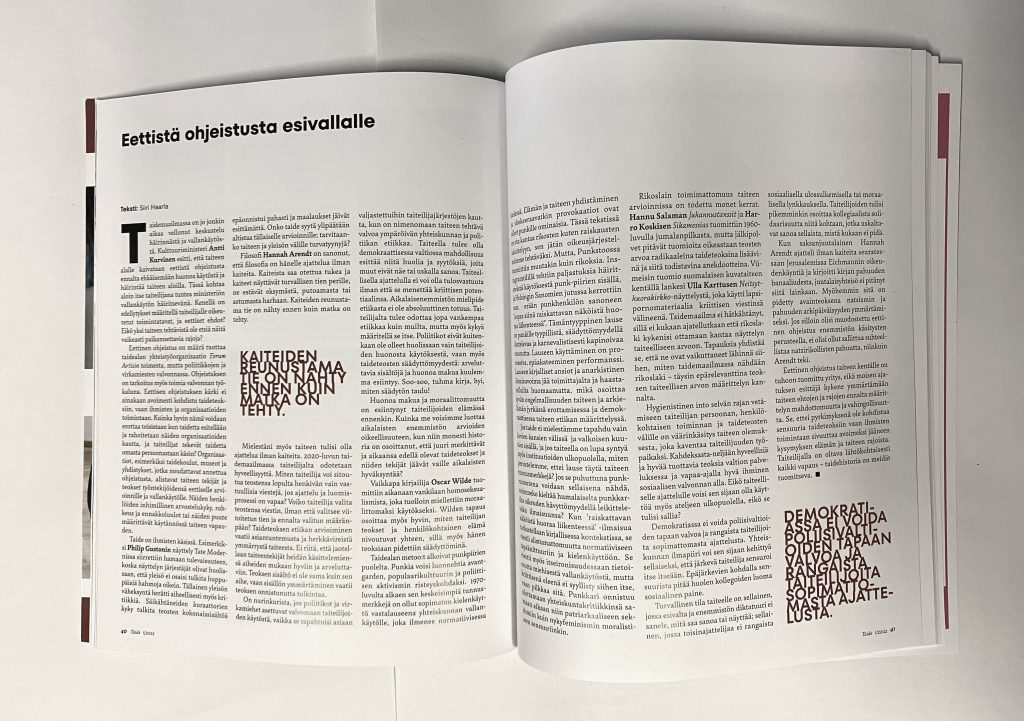
After handful of examples, her conclusion was that art does not need or benefit from such guidelines. It is like philosophy, where thoughts should appear without protective fences. Without cushions. Without handrails. For sure, some prefer to have handrails, that lead you safely to destination. Prevent getting lost and prevent falling. However, this protected and guided path that leads to firmly set destination. It is already seen, already walked, by countless people.
Her conclusion was firmly that there needs to be art without this type of strong safety net. Her criticism was directed towards common, utterly typical 2020’s attitude: Artists are demanded to be virtuous. Including not only their work, but also personal life. She asked, how could artist commit to responsibility, if work that is being done, is based on free creation without restrictions? How could one make experience of art safe, unless in form of restrictions and limitations? That would lead into favoring people and art that is norm and lukewarm. To using generally accepted and safe solutions, approaches approved by masses, as well as guiding people safely through the marked trail so there is no harmful misunderstandings. Any restrictions applied would be indeed restriction on artist as person. The way to enforce ethical guidelines to artists behavior, by various types of suppression, would have direct result of suppression of art itself created by such people.
She felt it was alarming, that politicians would step in, to give ethical guidelines to artists and therefore also art itself, when direction should be exactly the opposite. It should be art, that is able to touch topics that are difficult, challenging or perhaps even not allowed to be spoken loud. To comment also political and social issues from less popular perspectives. Including using language and harshness that is needed, even if it would not be nice.
The more curious this essay becomes, when Siiri Haarla takes fairly outrageous examples to back up her conclusions. She mentions Ulla Karttunen, another female artist, who got sentenced some years ago for indecent underage photography used in her exhibition virgin-whore-church. She says nobody in world of art was budged. Artist was not outcasted. Consensus was that criminal law is not the valid art critic. Value of her work could not be determined based on whether it included something illegal or widely disapproved. According to the law, she was guilty of downloading material online, and putting these illegal prints into new context in form of artistic expression. In Finland, this is the one category that is clear in criminal law. Displaying sexual obscenity including minors is illegal, despite your intentions. It can not be justified or excused with artistic merit. You can get prosecuted for wide variety of other things, but all the other stuff one can, at least theoretically, defend as artistic expression.
Nevertheless, despite being illegal according state of Finland and perhaps pretty much every civilized nation, Haarla stood firmly convinced that this does not define actual artistic value of the mentioned exhibition. Not having seen any of it, I can’t make anything else than enlightened guess. My assumption is, that this exhibition may have been something, that could not be done with substitutes, without compromising the intended impact. Was it wise, legal or right thing to do, are questions that can be asked, but those may be exactly questions in-build into experience of exhibition. If it was perfectly safe and legal, the piece would not be what it was. Law could not see anything else but firmly set rules, world of art could see the point. Be disturbed and perhaps shocked, when being revealed something that remains hidden in society – but is there. Facing the necessity of thinking role of women, religion, institutions in given perspective.
Stories published by Punkstoo included cases of flat out rape and abuse. Those Siiri Haarla ruled out from artistic realm, as issues to be dealt in criminal court. After excluding those obvious cases, fairly interesting view emerged. Instead of being offended by the harshness of accusations that kick-started whole thing, she was more focused on the other stories, that started to come after them.
Certainly, guys like myself had been quite amazed. Besides rape and violence, vast majority of stories fell into categories where biggest questions could have been: Why are we even talking about these things in same occasion? This question tends to be lumped in category of shaming victims, but I personally see that it is absolutely the opposite! Isn’t it a bit disrespectful towards rape victim, that they were next to stories of scene girls regretting youthful drunken bar nights ending up consensually sleeping around with older guys. Now decade later realizing guys were not respecting her as individual. Just wanted to fuck her. Or stories of metal chicks entering the backstage of metal gig, and treated as a groupie… No shit? What else would be found there? Is there anything in heavy metal culture that indicates late night backstage is milieu of… something very enlightened behavior? Or socially awkward guys making clumsy and embarrassing flirting attempts that annoyed woman.. but offense ended there. So many stories fell into category of: Life. We all just have to cope with minor nuisances and incidents once in a while. I was amazed these “testimonies” were approved side by side among graphic stories of sexual violence and dehumanization.
I am fully aware, that this attitude may stir some hurt, but art may actually have solutions for processing complex questions, that would be benefit over victimhood becoming divine status.
Siiri Haarla picked up her favorite moment, which was fairly controversial. Some drunken punk had been reported to blurt out in public place, when seeing some women walk by: ”these are some rape-worthy whores”! Haarla argued, that this is prime example of carnivalesque rebellion of punk. Insensitive provocation. Rejection of the social norms (in its context of usage, that may be environment demanding political correctness) and so on and on. She argued that art does not happen merely inside white cube, the gallery, where it is safely isolated from real world. Art can be pure expression itself, happening in the real world. Also as spoken piece like this. Like public poetry. She felt that public performance such as this can reveal a lot. Anything from prevailing social norms, patriarchal society as well as moralism of contemporary feminism. Perhaps! Other guess is that this part of text is sort or art project in itself. With saying this, she might have also thrown a bone merely as a test. To see who is the first one to run after it… while furiously barking? Essay itself, probably used a bit of methods she associated with punk.
It is curious that for many female artists who demand safe space in art, it means something completely different thing. Instead of in, Haarla advocated safe space for art. In her terms it meant that authorities or dictatorship of majority should not dictate what can be said and how it can be said. That dissident would not be outcasted or morally lynched, as it is counterproductive for art itself. This is up to debate, of course.
She made argument due common observation, that prevailing climate in art world can quickly escalate into situation where rational artist will apply level of self-censorship. Less rational ones will be kept in leash by peer pressure. This certainly effects what art becomes, and will effect how we relate with it. It is far from unrestricted free creation. Far from creative flow. It can become calculated, just to make sure one is not cut off from entire milieu. If you want to belong to art community, you submit to its prevailing rules.
It is not difficult to see this same dilemma could apply in context of noise.
While punkstoo phenomena was literally everywhere else in Finland and branched into other genres of music, perhaps due small underground nature of noise, nobody really speculated potential wrongdoings or harmful attitudes that may or may not exist in realm of noise. Certainly, there was at least one occasions where it was being wondered. Why ongoing punkstoo and metaltoo did not reach noise scene and should it be brought up in noise forum(s)? More realistic people mentioned that it may be futile attempt to stir polemic at, for example, Special Interests forum. For various reasons, but perhaps most of all expectation that there are some noise guys who simply do not swallow this type of reasoning without questioning its validity. In some other genres, any sign of criticism or question, which is something else than pure empathy, would face hostile demand that one shall not question how someone felt situation to be.
This is curious element to observe. Nowadays (2022) we do have healthier situation in global noise scene: There exists again more than one noise forum, dedicated for noise discussion of all types. This enables one to start to find what kind of things may be social norms in context of specific platform. Be it one or another noise forum, or perhaps some specific social media group. As funny as it may sound, these may deliver enough data to enable some sort of conclusions.
It doesn’t take you long, to see same people, who are edgy loudmouths on one forum, but remain somewhat polite and easygoing on the other. And others exactly opposite with reversed roles. It is interesting to observe type of person, who keep their shit together if required to do so, but any given opportunity keeps stirring drama, including personal insults.
After few examples on platform, one may lean to adjust control or even self-censorship according to peer pressure. Just to be able to stay in social media group without being kicked out. Not post wrong kind of remarks or pictures of wrong kind of records. Sure there is positive sense. Like when peer pressure seems to happen in form of advocation of no drama, no personal attacks. It just creates environment, where all things noise is fine, but bitching and stirring shit ain’t, and it works surprisingly well.
No matter what people may claim, we do have taboos and transgressions in noise. It is no less transgressive, if phenomena is as old as mankind or regularly dealt within art. It is clearly transgressive (meaning: going beyond the limits of what is morally, socially, or legally acceptable), if it factually year after year, keeps stirring mass of anger, furious debate, calls for boycotts, calls to outcast people and perhaps also some sorts of cancellations. Even elevated level of dislike, that is just too much for one to be able to not start making remarks about it.
In context of noise scene, some may have found out that as simple thing as posting picture of your favorite power electronics album, or been known to know someone, can put you close to be outcasted in part of scene where you operate. There has been incident where posting picture of what you are currently listening, resulted being kicked out of noise compilation line-up you had been invited to. Sure, one can’t say label bosses wouldn’t be entitled for this type of curation, but one can’t pretend that it would not be highly amusing or revealing how this level of social conduct is enough to dictate that we want nothing to do with you.
What is the reaction towards artist, or band, who would create pieces, where core of expression is equivalent of yelling something about rape-worthy whores? What could be achieved with this type of expression, under what circumstances?
There is a piece of writing in Special Interests #13 magazine titled Beyond Industrial Noise?, that deals more in depth with positive side of art (or noise) being treated as real deal. Its conclusion was that sacrifice to become outcast, is worth taking for artistic integrity. People who are unable to get it, are not the audience. They are more like landscape of the art happening, than the actual audience.
It is most of all good for art, or noise, that this group of people assumes there is reality behind the art. That it is not done for sake of show, but artist means what he says to certain extent. That mentioning rape-worthy whores is perhaps somewhat truthful account of his hidden attitude towards women in general, that normally is covered under good manners. This brings vastly different emotional impact, compared to ruling it out merely as ”ahh just art”, thus making it relatively ok.
The focus point of this text, is meant to be art or noise that is conceptually questionable and hard to justify as good things, unless you are able to accept art that may not be victimless. Art that may have been, or remain to be harmful. This is interesting line to draw, since beyond the line, can be found something that still has potential to force one to ponder where line must be drawn and why. Material in other sides of these lines may not be artistically better or worse, but there might be intrinsic difference.

While ago, I purchased art book by Issei Sagawa that came out 20+ years ago. It is curious example of art, that some people could file as at least moderately offensive.
Sawaga is Japanese murderer, cannibal, and necrophile known for the killing of Renée Hartevelt in Paris in 1981. He is certainly celebrity, and should be widely known among noise fans. Sagawa murdered Hartevelt, then mutilated, cannibalized, and performed necrophilia on her corpse over several days. This is what his book deals with. Bizarre graphic manga, that is factual first hand recollections by man who committed these things for real. His own drawings depicting entire gruesome incident is done with exhilarating style. Colorful, naive, amusingly bizarre style of drawing, what reeks lack of traditional artistic skills, but in opposition there is obsessive level that feels like one must do this thing. Like looking at page size clumsy drawings, where artists self portrait is holding severed head, watching himself in mirror, making amusing comments towards himself.
Big part of the charm here and, hence, the high price and collectability of the book, is fact that it was written by Sagawa. Not by someone else. For those who may have missed the story, Sagawa was certainly arrested quickly after murder, but released after two years of pre-trial detention upon being found legally insane, therefore not imprisoned. He was deported back to Japan.
Sagawa was released due to a simple legal technicality. French authorities failing to send paperwork in time. As in Japan, he was considered sane and healed, and because he was never in trial or convicted to prison, he walked out as free man. Sawaga became such a media celebrity in Japan that it led also to international publicity. Cannibal, murderer, and animal rapist as celebrity! What a mockery! He was involved in putting out multiple books, often dealing things he had done. This own art book about things he had committed, is therefore moderately offensive, perhaps!
It brings interesting questions how one should relate to art, that is… not victimless? Art that is also utterly malicious. Perhaps even mockery towards victim(s)?
It remains interesting for me even if we would not talk about art of the actual criminal, but someone who deals with theme that by common standards of society would require respect and caution, but is approached with total disregard of common decency.
Back in the 90’s, Cold Spring released Sutcliffe Jugend ”We Spit On Their Graves” CD. Best cuts of the 10 x tape set that came out on Come Organization in 1982. Material that remains one of the most violent power electronics creation still today. There was T-shirt too. Label issued warning, that wearing the shirt in public happens with your own risk. List of so called Sutcliffe’s ”tour dates” was printed on the back side of the shirt. Even if there was more than decade since last kills, t-shirt was nothing very hip to wear in UK. One can easily imagine situation that some upstanding citizen standing behind your back, would feel tempted to smack with open hand the obnoxious brat who thought it was good idea to wear that shirt in public. Unwilling to hear any explanation of artistic intentions.
The brutality of Sutcliffe Jugend name may be clouded during decades. Pre-SJ was called Death Squad. It was William Bennet of Whitehouse who suggested new name. Peter Sutcliffe had made his last murder in 1980 and just been sentenced in summer 1981. Already in 1982, re-named as Sutcliffe Jugend, project issued both, ”Campaign” tape and ”We Spit On Their Graves” 10xtape box. Some of the most disturbing electronic noise assaults ever captured on tape. Not only that, but sheer brutality and maliciousness of themes of the work would make most of industrial music of the time soft in comparison.
There are no shades of nuance to be found that could make it easy for listener to rely that material has some sort of intelligent artistic commentary behind it. When SJ is painfully shredding listeners eardrums, and titles are referring or seemingly even celebrating all sorts of antisocial, destructive and perverse things, it must have been quite beyond to receive this in mail when it originally came out. Minimal non-explanatory presentation of these works, would certainly qualify as art, where there is no safety net or handrails leading to nice conclusions. You just have to cope with it, and you can not trust it leads to anything nice.
People like earlier mentioned Siiri Haarla, have rightly defended idea that content of the art is not same as topic of the art. This is obvious in a lot of industrial-noise, where to truly understand what release is about, requires ability to see content over topic. What if things get into level of discomfort and vileness, as they are on We Spit On Their Graves? When material itself is so crude and raw, it hints that expression was not by artists, but.. someone else. It could be very well the fact, that there is no difference: Topic may be the content here. Unless one extends the content being listeners experience and thought on given topics?
As much as you want to believe there would be some underlying positive deeper substance, it may be that there is none. At least none intended at the time, by the makers. This will not exclude the possibility of seeing and theorizing there is one. Creations are no longer in sole ownership of artists, but out there. To be experienced, discussed.
There was recent good interview with John Balistreri of Slogun aired at Noisextra podcast. (https://www.noisextra.com/2022/03/09/in-conversation-with-john-balistreri-slogun/ )
There was moment, where Balistreri was talking about early vocal style of Slogun. His true crime era, where vocals would be high pitched, almost teen-esque screamo anguish. There was interesting discussion about how this connects to idea of troubled teen and true crime. They would proceed into discussion, where killer would not be only monsters or pop culture hero. There would be almost tragic elements of the loneliness of the serial killer. The guy who commits historical acts, but can not talk about it with anybody.
One could assume that man must be most of all troubled. Most likely since youth. Somehow disturbed. One can wonder whether he is above the average man, making his own destiny, or if he is actually below it. Unable to control his life to fit into requirements of normal human life. It is possible that very often, he is not a guy to look up and admire. This doesn’t make it, or him, less interesting. Often we face the assumption, that certain type of people would admire or celebrate the killer. This doesn’t seem only way to go. We can see other elements in killers. Especially those, who will not cry instantly about something being unacceptable or beyond reason.
I recall zine interview, 15-20 years ago, where he was being asked about glorification of killers. Can’t remember exact words of either question or answer, but the core of the reply was that Slogun was not celebrating the murderers. Balistreri said, that of course, every single one of them should be executed for what they did.
The desperate and nihilistic screams of disturbed young man would be expression that doesn’t necessarily reek of confidence and power. Instead there would be equivalent of something what goes in the mind of troubled young men that are on the way of becoming historical figures. Typically it tends to be someone who may have started with animal torture and cat killing, and slowly proceeding into human victims. For decades there has been entire popular culture industry revolving around it, but I don’t think most of it can deal with it in same way as industrial-noise! I don’t feel there has been too much works in movies or documentaries that really display inside the mind. At least noise has certain potential, that book or movies don’t have simply due the way of expression. (Excluding certain titles, of course.)
It could make us appreciate, think and possibly understand things that other type of art could or would not offer. Things that “unacceptable art” can.
Perhaps even the creator itself, in elevated levels of self loathing, depression and disappointment, doesn’t quite get it while it is happening. Eventually during the process, suddenly realize where it is going. Discoring more being in his art, that was originally intended and aimed for. Suddenly, years later, realizing how some of the urges and formerly incoherent vision he tried to put together, somehow reveals itself. It would be foolish to expect and demand that artists fully knows and is able to articulate piece for you. We may be in situation, where it takes time before articulating something shows how much more it was than just childish provocation. Even artists may discover formerly unhealthy state of mind and comparing it to detail of vocal style, may be the key to unlock new door to find way to go deeper in works that was not possible at the time of creation.
Thing is, that it would be very hard to truly find out, what was going on artists head, when something was being done. We can not realistically go into head of teenage years Sutcliffe Jugend, Whitehouse or Consumer Electronics. These protagonist can be mentioned as obvious examples. What they say in 2020 about things they dealt with, may be vastly different than intentions were at the time. It is not even matter of dishonesty. Not at all. Simply factually being now different person than decades ago. Now they may experience their own works in new light, as not makers but outsiders. Calling oneself as obnoxious brat may be real now, but what the obnoxious brat was doing then, may be entirely different reality and motivation.
This might be easy to observe with your own creations. At least for some. Try to understand motivations of decades younger self, ain’t always obvious. For example, I could be describing what was the intent of doing private performance art, in form of urinating on killing site of teen girl, student of my former high school. None documentation was published, but theme dealt in Grunt ”Dead Beauty” 7”. Or killing small rodents and jerking off on them, filming it to be screened at a show and publish it – for sake of art.
It is like situation when the law enforcement pays you a visit, and you try to say that ”it ain’t what it looks like..”, and then this interaction may result you to start to wonder what the hell it really does looks like? Especially if taken out of context. Law enforcement did not enjoy Trite DVD. That I can assure you. It was not illegal, up to level of being dragged to court. How it is perceived may rely quite a lot on perspective. For the maker, there seemed to be good reasons why certain things were done. Even explained in work itself. Those creations just would not been the same, if they were done in other way. At least in personal perspective, one would need to push it further, than would be fun to do.
It would be hard to measure weight of those reasons years later. While this particular release itself has certain amount of depth and complexity, one could still ask legit question that what part of the thing is art, and what is the pasted-on excuses from apologist who tries to reason something that is most of all utterly cuntish behavior? It is certainly nothing to regret or apologize! Certainly it was not fun to make nor it is fun to watch, but there are other qualities. We may object, or we may see what this piece of art makes possible to deal with. Engage in it, unless it would be futile due not getting anything out of it. This would be most likely realistic expectations. It is for very very niche audience.
What we can know, is that from this type of process, boils up quite spicy soup. Book like Issei Sagawa’s ”Manga Sagawa-san” could not be this particular art and this expression, if it was done by someone else, or from angle of regret and apology. Detailed bizarre drawings of perhaps mentally unstable murderer, or someone who has formerly been diagnosed to be so – are clearly other kind of art, than creations of some other type person. Like someone, who would be there merely to attempt to shock. It awakes other type of questions and concerns. Perhaps even fans of morbid art have not used to ask themselves these in depth. Does the work require or benefit of even actual act of murder, and if so, what to think about it? And can there be more than one accepted answer?
Relationship of art and artists in curious. While artists persona is what enables art to be what it is and therefore almost inseparable, the artistic value of the work can be judged also separately.
I am not personally really shocked by most things. I don’t see most of noise releases from perspective that they would be intended or designed to shock or offend. I have hard time believing so badly distributed items would go to elsewhere than fairly experienced audience who knows the drill. Shock would probably require other types of audience, so this material may have other functions.
If you are member the most obvious audience that there could exist for type of works, there is still difference of seeing something that has extra level of maliciousness, that works certainly ceases to be fun. Like, who would not be just filled with some sort of satisfaction when seeing nice pile of random corpses? Exhilarating pop-culture type violence? It is more like aesthetically pleasing, than anything brutal or offensive. For sure, one could even consider it as fun. There is a lot of nasty sex, violence, antisocial acts of many types, that appears in some level, fun.
When Nil By Mouth Recordings put out debut tape of project called, Utøya, and when first exposed to it, it gave appearance of not being fun. I am not indicating I would display here some sort of moralist statement. Simply describing the difference of atmosphere. Utøya, project is named after island where in year 2011 Breivik committed the largest mass murder of Norway, killing 69 youths. “Preying Upon Your Youth”, special packaged tape, limited to 69 copies, one per victim, included map of the incident, real blood, and whatever things one could expect from special packaged noise release. It came out in 2018. Seven years after the incident, first feeling was that this is pretty damn harsh. Not in a funny way. Not in ways like rad dude! Appearance was legitimately dark and malicious. It had certain impact even if the noise, in my ears, doesn’t sound anything remarkable. There is absolutely a difference, where something ceases to be nice or worthy of glorification or even approval. Why would one want to revolve around this, in this way? Exactly because there is possibility of having artistic expression that would not have same effect if toned down and abstracted. Even holocaust, is distant and vague, compared to this. Tape is very hard to claim to have potential for being largely accepted and cool, yet that doesn’t lower its potential as example of approach.
There is always possibility to conclude that approach is cheap. Most of us now what are the weak spots. Things that pisses off people. Exploiting these things, may be considered cheap. However, even in the pure exploitation, there may be levels of artistic value. Work we see, could not be done without certain amount of exploitation to get honest emotion or thought.
It can easily reveal that instead of evaluation of art, we often see reaction far more based on moralism. It doesn’t have to be even anywhere near level of above described release. I’ve said it many times, but I simply do not buy it, that all the hostile agitation that power electronics can ignite, happens because someone was bored. That someone felt this is not good as art. Some people do have that as legit reaction. They are usually bored enough not to even waste time of talking about it. They would not waste time on clicking report and bitching moderator demanding action.
I’m talking about the nonstop agitation, reports, cancelling items from market places, calls of boycott, smear campaigns, broken friendships, prevented gigs and so on. It would be quite amusing level of self deception to say this happens because art was lame and old, so already seen. The same stuff so many times. Sure there is repetition like there tends to be in everything. It would be at least honest to admit, that one lost his shit, being unable to deal with own emotional response with something, that simply could not be tolerated and accepted. That you were triggered, and no longer able to do anything else than just act accordingly.
While ago I was listening interview with Finnish visual artists, who talked about simple test to find out who is actually boss of in your life. He suggested, that the typical middle-class citizen could just… go to supermarket and steal candy bar. Sure, it is illegal. Sure it is not approved in society, but it also reveals something about you, if you could not do it. If you could not do it even as a test that doesn’t have to mean anything to you. You do not have to want to do it. Just a test you do regardless. It barely takes time or effort.
This unability to make simple conscious decision, that is basically harmless, will reveal something. If one is scared of consequence or is unable to reject social norm in absolutely minimum level of “harm”, then clearly you are not in charge of your life. Someone else, or something else, dictates how you must behave, what guidelines you must follow – no matter what. Saying that you could do it, ain’t the same as to do it. We all could do whatever, but we don’t.
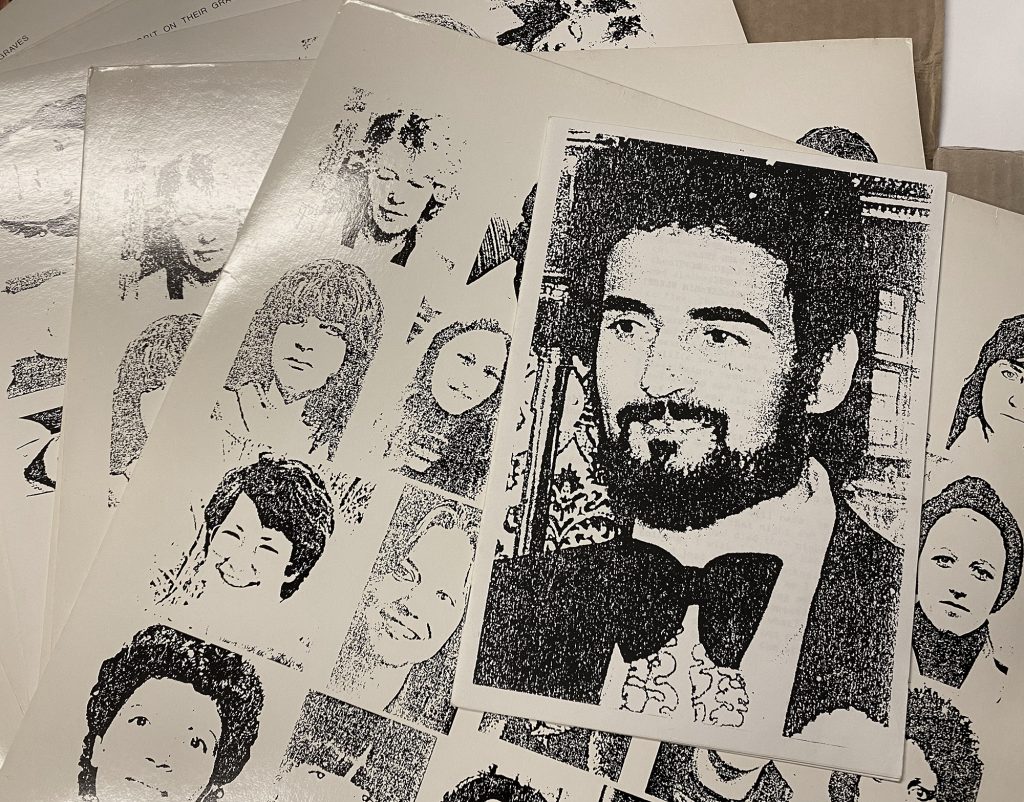
When listening ten hours of Sutcliffe Jugend noise, from 1982, in two chunks of 5 hours, for me, it was fertile soundtrack for thought. As little guidelines as song titles provide, they do seamlessly melt with type of sound where the raw and painful noise becomes the same as the impression of track titles. Blunt and direct titles such as Laceration Fatal, Trained To Murder, Cock Dominant, Whores Death, Sex Beast and so on becomes one with the sonic equivalent. The work where both audio and the “message” present zero empathy, zero concern of other peoples comfort, zero disregard of other peoples hurt emotions. It somehow instantly connects this with the mental disturbances of Issei Sagawa. Songs such as Necro-Sadism, Corpse Fuck, Body Battering could be almost like audio equivalent of what sort of cold blooded obsessive thoughts were possibly possessing Issei Sagawa’s brain when he went through desires – before finally actually committing it for real.
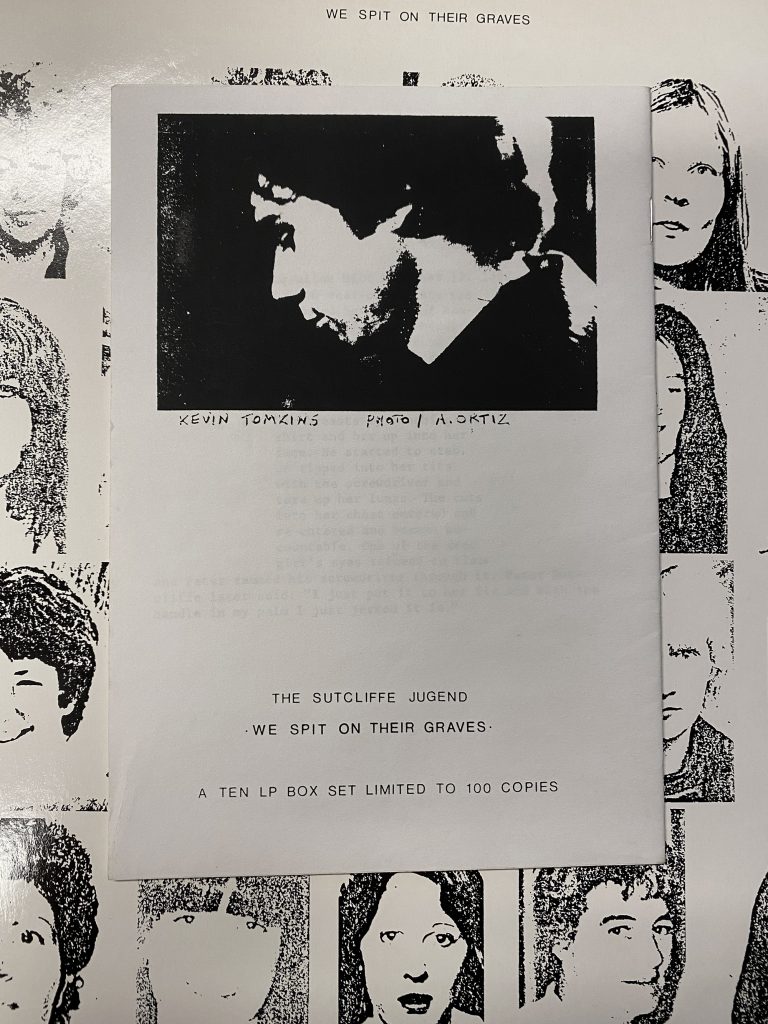
Not everyone is interested to dive into that type of state of mind. That is fine. They may also enjoy the good noise as pure energy, ignoring the rest. Or taking it merely as suitable expressions of ugliness and power play. I am still sort of surprised that this interest would be perhaps growingly marginal and growingly moralized? For example, one can’t help but notice this with SJ’s help. SJ may be, but a lot of other noise of this category is not considered art in ways as real art would be. I mean in context of NOISE. Often seeing attitude clearly being that Snuff, Taint and Brethren could not be discussed along appreciation of greatness of Dave Phillips and Merzbow. As if their artistic work would be profoundly lesser of value, simply due the slightly unlikeable or difficult topic?
I do not feel much common with the ”freedom of speech” -advocates. For me there appears clear difference with that, compared to all things I’ve been writing about. Some feel that noise makers would not be able to do what they want. Of course they can do exactly what they want, IF they choose to do so. My approach is not about freedom of artists, but observation of what kind of climate would be within genre and what is the result if genre largely willingly submits to something that is equivalent of minister of culture delivering ethical guidelines. Clearly having no clue about art itself.
It’s more about being critical on wide acceptance of simple minded knee jerk reactions and acceptance of climate it creates. Limitations called for and applied by people who clearly are, far more simple minded than you’d hope them to be. It is expected, but why that would be largely unchallenged?
I do not think all noise should be outrageous, disturbing and rude. Not at all. Most of stuff I listen to, is not. I just see that situation is counter productive if absolutely brightest, innovative and revolutionary releases are in role that they are preferred to be ignored, simply because we accept lame discourse brought, often from external parties. Noise tourists, music festival curators or something.
Moralism is not very admirable quality. I do not think it has strength in advancing creativity and making expression that can enable more than expected. Moralism itself clearly makes one blind to even see it, even if it would plain sight before you. If there is fairly largely accepted ethical code of ruling out and dismissing some of the great works, it seems a bit shame in context of revolutionary nature of culture. While we could be appreciating many artists now, most of people appear destined to give it, lets say, safe distance of 40 years, that allows odd alchemic maturation process to happen. Suddenly material is almost gallery worthy and you can accept the strong, creative, somehow illuminating and strongly expressive qualities of material like Sutcliffe Jugend.
In 2022, Vinyl On Demand will be partially reissuing WSOTG on massive Sutcliffe Jugend vinyl box set. It may be now more of document of something that was, not something that is. How good it would have been, if there was documentation that was about art when it was happening, excluding the safety of distance. I gladly keep eyes open for the new offenses, by new artists, what would make me question or think things I often swallow without blink of an eye. It could be nasty or it can be nice. Some sort of lure of darker side certainly makes me little biased towards the benefits of nasty.
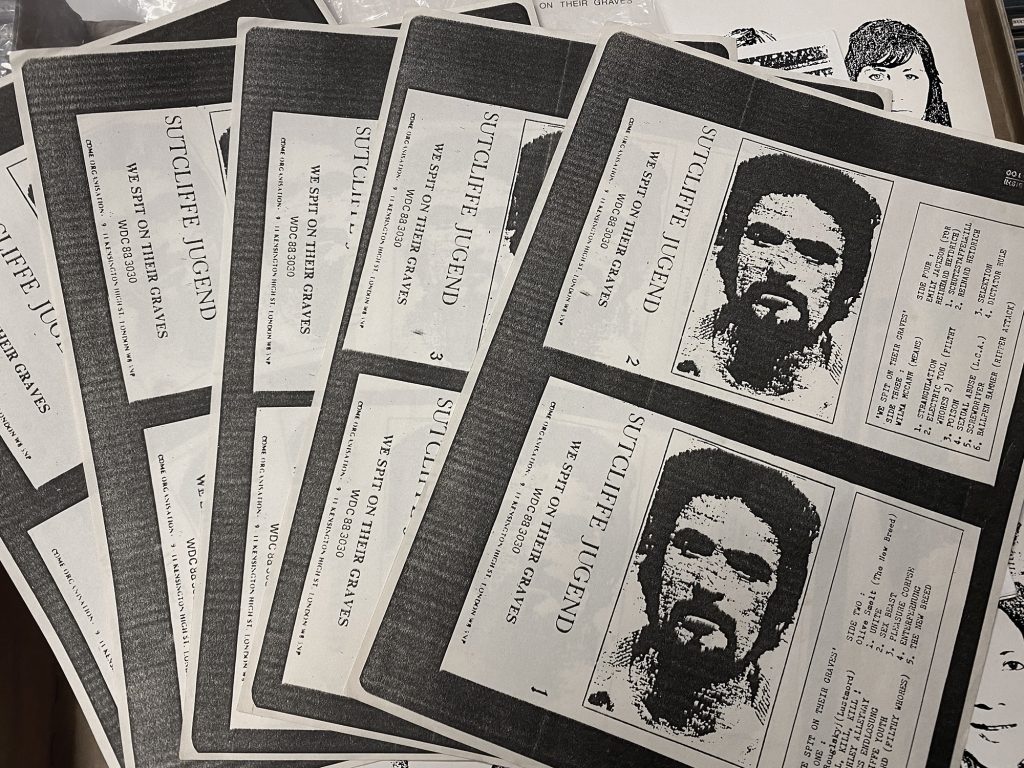
Additional:
Some examples of Siiri Haarla’s paintings. Google for more. https://annituomi.com/Siiri-Haarla
Sutcliffe Jugend box set to come out on Vinyl On Demand: https://www.vod-records.com
Nil By Mouth, label who put out Utøya http://www.exoteric-zine.com/nilbymouth/index2.htm

